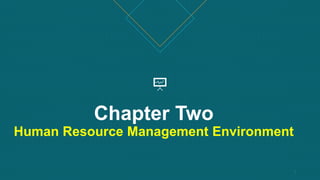
HRM CH-2 Yoni.pptx
- 1. Chapter Two Human Resource Management Environment 1
- 2. After completing this part, participants will be able to understand: 1. HRM Environment 2. The External Environment 3. The Internal Environment 2
- 3. The Context of HRM 3 Utility of Analysing the Environment • To become proactive and not remain reactive to the environment. • Reactive strategy are useful in stable and competition less environment. • Today’s environment is characterized by intense competition and change where proactive steps are vital to survive.
- 4. 1. Human Resource Management Environment Human Resource management as a system is affected by several factors including external and internal environment. • External Environment are those factors that are outside the organization, they are largely uncontrollable and provide opportunities and threats (OT) to the organization. The analysis of external environment is some times called PEST analysis • Internal environment are factors within the organization, they constitute the strengths and weaknesses (SW) of the organization. • The analysis of the internal and external environment together is called SWOT analysis. 4
- 5. External Environment 1. Political/legal 2. Ethical 3. Economic 4. Social 5. Technological Internal Environment 1. Vision, mission, 2. Organizational styles, leadership 3. Organizational Structure 4. Nature of the task 5. Work groups 5
- 6. 2.The External Environment 1. Political/Legal Governments make different laws that require human resource management to respect. Laws include: Equal employment opportunities, Affirmative actions Compensation and benefits Safety and health, Hours of work, holidays, Industrial relations etc. 6
- 7. 2.The External Environment 1. The Legal Environment of HRM Equal Employment Opportunity Discrimination Forbids discrimination in all areas of the employment relationship. Employment based on age, sex, disabilities, national origins (ethnicity), religion, compensation (payment on similar jobs) etc. 7
- 8. 2.The External Environment 1. The Legal Environment of HRM Equal Employment Opportunity Affirmative Action Governments encourage Affirmative action: the commitment of employers to proactively seek out, assist in developing, and hire employees from groups that are underrepresented in the organization. Various executive orders, require employers to develop affirmative action plans and engage in affirmative action in hiring women, the disabled and disadvantaged groups. 8
- 9. 2.The External Environment 1. The Legal Environment of HRM Compensation and Benefits Fair Labor Standards Acts Sets a minimum wage and requires overtime pay for work in excess of 40 hours per week. For non exempt employees Salaried professional, executive, and administrative employees are exempt employees who are not paid overtime provisions 9
- 10. 2.The External Environment 1. The Legal Environment of HRM Compensation and Benefits Employee Retirement Income Security Sets standards for pension plan management and provides federal insurance if pension plans go bankrupt. Family and Medical Leave Act Requires employers to provide up to 12 weeks of unpaid leave for family and medical emergencies. 10
- 11. 2.The External Environment 1. The Legal Environment of HRM Health and Safety Occupational Safety and Health Act (OSHA) requires that employers: Provide a place of employment that is free from hazards that may cause death or serious physical harm. Obey the safety and health standards established by Occupational Safety and Health Administration (OSHA). 11
- 12. 2.The External Environment 1. The Legal Environment of HRM Labor Relations Sets rules on how employers and employees relationship is governed Joining union Establishing union Bargaining in good faith etc. 12
- 13. 2.The External Environment 2. Ethical HR practices: HRM practices must result in the greatest good for the largest number of people Employment practices must respect basic human rights of privacy, due process, consent, and free speech Managers must treat employees and customers equitably and fairly 13
- 14. 2.The External Environment 3. Economic Environment: Economic growth, industrial production, agriculture, population, national and per capita income, business cycle , inflation, competition, money & Capital market etc... 4. Socio-Cultural Environment: such as demographic factors, culture, religion, belief on work etc. 14
- 15. 2.The External Environment 5. The Technology Challenge: Advances in technology have: Changed how and where we work Resulted in high-performance work systems Increased the use of teams to improve customer service and product quality Changed skill requirements Increased working partnerships Led to changes in company structure and reporting relationships. 15
- 16. 2.The External Environment 5. The Technology Challenge (Con’t): Advances in technology have: increased the use and availability of Human Resource Information Systems (HRIS) increased the use and availability of e-HRM increased the competitiveness in high performance work systems 16
- 17. 2.The External Environment The Global Challenge: To survive companies must compete in international markets Be prepared to deal with the global economy. Offshoring – exporting of jobs from developed countries to less developed countries On shoring – exporting jobs to rural parts of the United States 17
- 18. 3.The Internal Environment • Vision mission objectives and strategies - HRM require to align its activities to these requirements. • Styles of Management - the styles of management whether it is autocratic, democratic or laissez fair. • Nature of the task - whether the job is attractive or repulsive • Organizational Structure - Number of positions and relationships. • The work group - Whether the work group is supportive. 18
- 19. Thank You 19